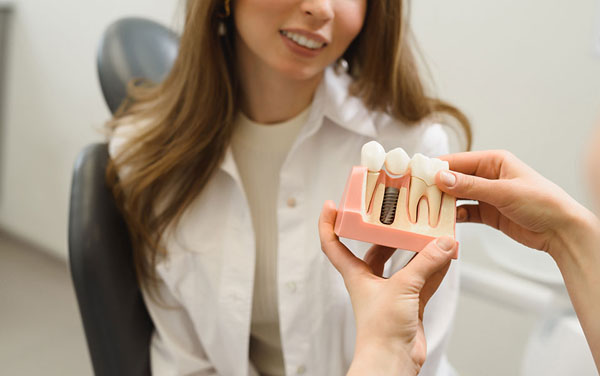Tooth Loss and Your Options for Replacement
Losing a tooth can be traumatic, leaving an empty space that affects your smile, your ability to chew, and potentially your speech. Replacing a missing tooth is crucial for both health and aesthetic reasons.
When looking to restore your smile, you typically have three main options: dental bridges, dentures, or dental implants. Of the three, dental implants provide the most durable and natural-looking tooth replacement solution.
Explore with Dr. Peter Patellis at the Kennett Center for Advanced Dentistry why dental implants are often the best choice for restoring your smile. You can also schedule your consultation at our Kennett Square, PA, dental office by calling 610-444-6311 today.
What are Dental Implants?
Dental implants are artificial tooth roots placed into the jawbone to hold a replacement tooth or bridge in place. An implant consists of three main parts:
- The implant body (the titanium screw fused to the jawbone)
- The abutment (the connector between the implant and crown)
- The dental crown (the visible artificial tooth)
The implant fuses with your jawbone in a process called osseointegration. Once healed, it’s incredibly stable and can last a lifetime with proper care.
Why Choose Dental Implant Treatment?
Dental implants have many benefits that make them the best option for most missing tooth situations. Reasons to choose implants include:
Preserving Your Facial Structure
Losing teeth allows your jawbone to deteriorate over time. This causes facial changes like wrinkles around the mouth and a sunken appearance to your cheeks and lips. Dental implants help prevent bone loss, preserving your natural facial structure.
Avoiding Bone Graft Surgery
If you wait too long to replace a missing tooth, you may need bone grafting before getting an implant. This invasive extra procedure adds to cost and recovery time. Getting timely implant treatment can avoid the need for bone grafts.
Protecting Your Healthy Teeth
Bridges require shaving down your nearby teeth to place crowns over them. This leads to an increased risk of decay or cracks in these prepared teeth. Implants don’t impact your healthy teeth at all.
Long-Lasting, Natural Looking Results
Properly cared-for dental implants have over a 95 percent success rate that can last decades. The custom-colored crown will match the shade of your surrounding teeth for a seamless, natural smile.
Avoiding Messy Adhesives
Unlike removable dentures that need messy adhesive pastes to stay in place, an implant replacement tooth looks, feels, and functions just like your natural teeth. This improves eating ability and provides stable, long-term results.
Restored Confidence and Quality of Life
Replacing a missing tooth with a dental implant can provide immense confidence and comfort improvements. Patients report enhanced self-esteem and no more worries over tooth loss or embarrassing slippage of removable dentures. This leads to a renewed ability to speak, eat, laugh, and smile freely.
Are You an Ideal Candidate for Dental Implants?
To determine if you qualify for dental implant treatment, Dr. Patellis performs a thorough evaluation, including 3D imaging of your jaw. Ideal candidates have:
- Healthy gums free of periodontal disease
- Good bone density with adequate width and height to secure the implant
- Proper spacing between teeth for the implant crown
- Realistic treatment expectations
Even if you don’t initially appear to be an ideal patient, techniques like bone grafting or sinus lifts can prepare your jaw for successful implant placement.
Dental Implant Procedure from Start to Finish
Getting a dental implant to replace your missing tooth involves multiple steps over several months. The basic process includes:
- Initial Consultation: Examination and 3D scan of the jawbone helps Dr. Patellis determine candidacy. We discuss your options to create an ideal treatment plan.
- Placement of the Implant Body: The implant screw is placed into the prepared bony socket of the missing tooth.
- Healing and Osseointegration: The jawbone fuses to the implant over two to six months. Temporary replacement options can protect the implant site during this process.
- Connecting the Components: The abutment connects to the implant body, protruding slightly above the gumline. Impressions help us design the visible crown.
- Crown Placement: The custom-designed crown is secured to the abutment, completing your implant. You now have a strong, natural-looking replacement for your lost tooth.
Proper care and regular dental checkups help ensure long-lasting function from your treatment. Brushing, flossing, and avoiding chewing hard items such as ice or hard candy can prevent damage and complications.
Discover Your New Smile With Dr. Patellis
If you have a missing permanent tooth, dental implant placement may be an excellent option for functionally and aesthetically restoring your smile. To determine if you qualify for this tooth replacement solution, schedule your initial consultation today by calling 610-444-6311 or requesting an appointment online.

